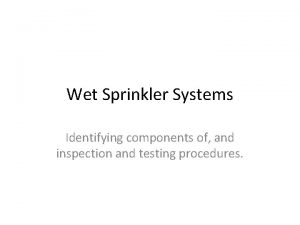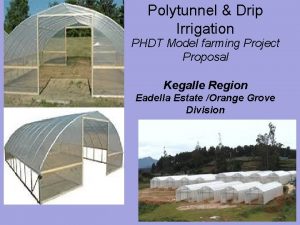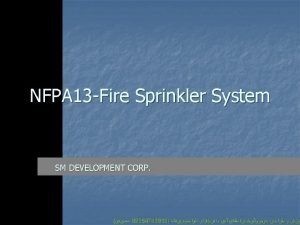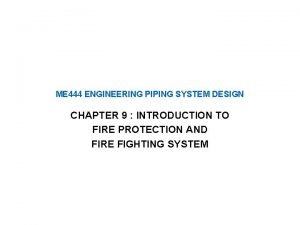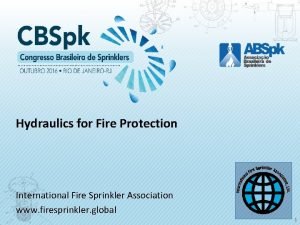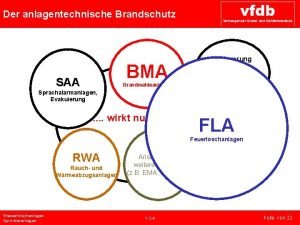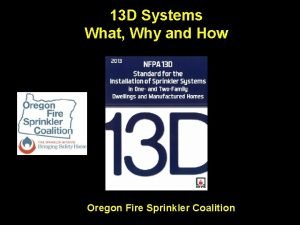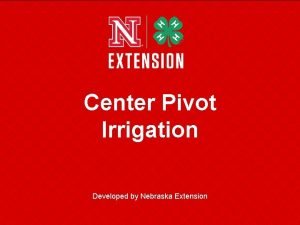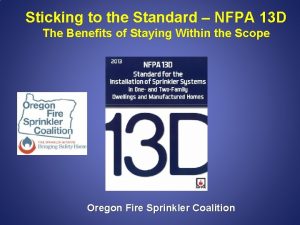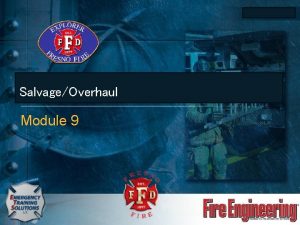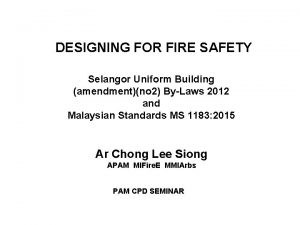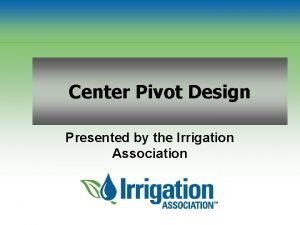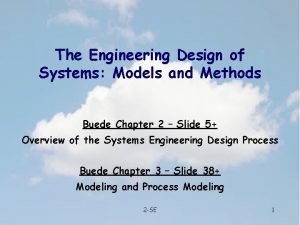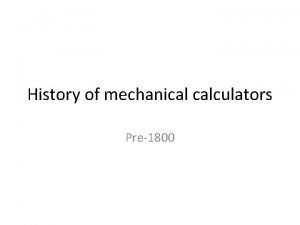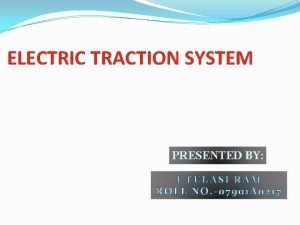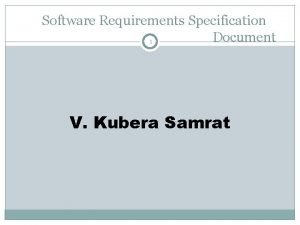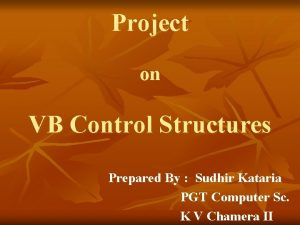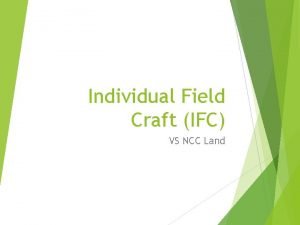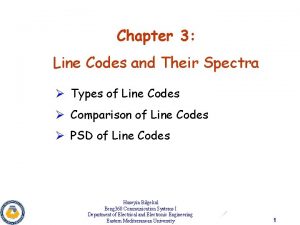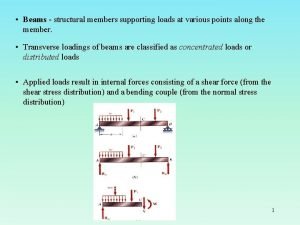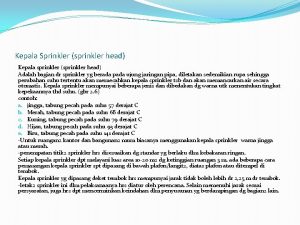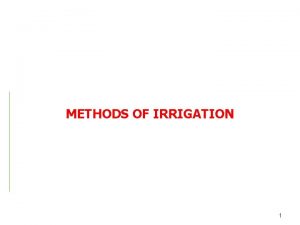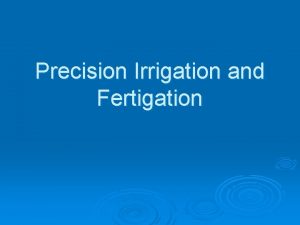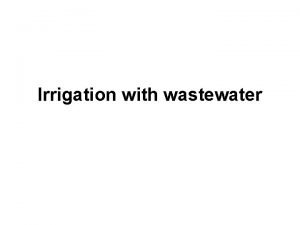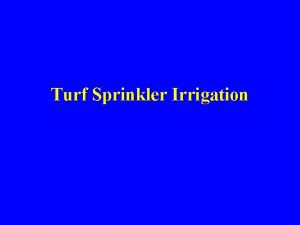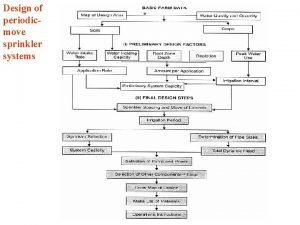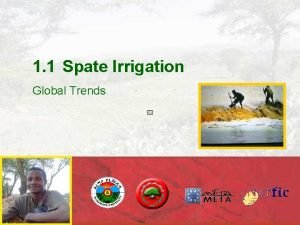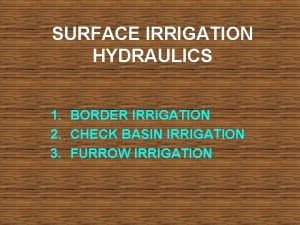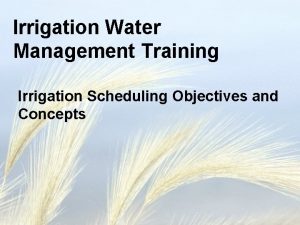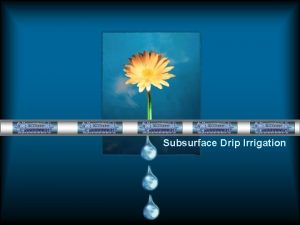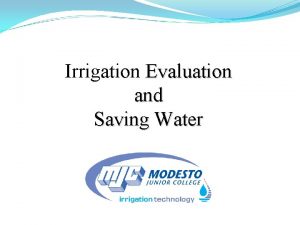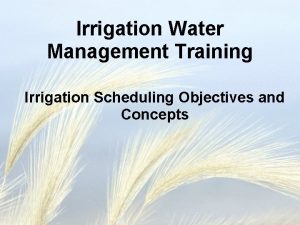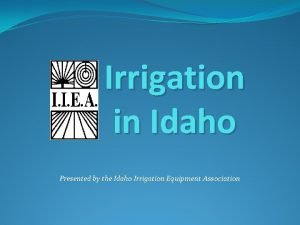Various Methods of Irrigation Design of Sprinkler Irrigation

























































- Slides: 57

Various Methods of Irrigation: Design of Sprinkler Irrigation System Ref: FAO Irrigation Design Manual (1988) Irrigation Management (Vol II), by DARA and Raghuvanshi (1999)

Types n Surface Irrigation Basin n Border n Furrow n n Sprinkler Drip Sub-Surface (Perforated underground pipes, or shallow groundwater) http: //www. fao. org/docrep/S 8684 E/s 8684 e 00. htm#Contents

Basin Irrigation n n Flat areas of land, surrounded by low bunds The bunds prevent the water from flowing to the adjacent fields. Basin irrigation is commonly used for Rice grown on flat lands or in terraces on hillsides. Trees can also be grown in basins, where one tree is usually located in the middle of a small basin. In general, the basin method is suitable for crops that are unaffected by standing in water for long periods (e. g. 12 -24 hours). Other crops which are suited to basin irrigation include: - pastures, e. g. alfalfa, clover; - trees, e. g. citrus, banana; - crops which are broadcast (sowing by spreading seeds, instead of precision sowing), such as cereals; - to some extent row crops such as tobacco. Basin irrigation is generally not suited to crops which cannot stand in wet or waterlogged conditions for periods longer than 24 hours. These are usually root and tuber crops such as potatoes, beet and carrots which require loose, well-drained soils.

Basin Irrigation Transplanting rice

Basin: for tree, for terraces


Basin Irrigation: Direct

Basin Irrigation: Cascade

Suggested Size of Basin APPROXIMATE VALUES FOR THE MAXIMUM BASIN OR TERRACE WIDTH (m) Slope % Maximum width (m) SUGGESTED MAXIMUM BASIN AREAS (m 2) FOR VARIOUS SOIL TYPES AND AVAILABLE STREAM SIZES (l/sec) average range Stream size (l/sec) Sandy loam Clay 0. 2 45 35 -55 5 35 100 200 350 0. 3 37 30 -45 10 65 200 400 650 0. 4 32 25 -40 15 100 300 600 1000 0. 5 28 20 -35 200 600 1200 2000 0. 6 25 20 -30 30 (Approx 1 cusec) 0. 8 22 15 -30 60 400 1200 2400 4000 1. 0 20 15 -25 90 600 1800 3600 6000 1. 2 17 10 -20 1. 5 13 10 -20 2. 0 10 5 -15 3. 0 7 5 -10 4. 0 5 3 -8

Border/Strip Irrigation n n Borders are long, sloping strips of land separated by bunds. They are sometimes called border strips. Irrigation water can be fed to the border in several ways: n n n opening up the channel bank, using small outlets or gates or by means of siphons or spiles n Strips can be 3 -20 metres wide and 100 -400 metres long. These strips are separated by low levees (or borders). n The strips are level between levees but slope along the length according to natural slope. n If possible, the slope should be between 0. 2 and 0. 4 per cent. But, slopes as flat as 0. 1 per cent and as steep as 8 per cent can also be used

Border Irrigation

Border Irrigation

Leveling effects

Border Irrigation: Stream size Effects QUARTER TIME RULE should be Applied

Quarter time rule The quarter time rule says that: The stream size should be large enough that (or the field size should be such that) the water should reach the end of the field (furrow irrigation) or for the water to cover the entire field (basin irrigation) in a quarter of the time needed to fill the root zone with sufficient water (the contact time). The contact time is the time needed to infiltrate the required amount of water & can be determined from the infiltration curve.

Infiltration curve Contact time

FURROW IRRIGATION n n n Furrows are small channels, which carry water down the land slope between the crop rows. Water infiltrates into the soil as it moves along the slope. The crop is usually grown on the ridges between the furrows. This method is suitable for all row crops and for crops that cannot stand in water for long periods. Irrigation water flows from the field channel into the furrows by opening up the bank of the channel, or by means of siphons or spiles.

Furrows and Gates

Furrow on Terraces

Developing Furrows

Furrow: Alternate Irrigation

Sprinkler Irrigation n Sprinkler irrigation is similar to natural rainfall. Water is pumped through a pipe system and then sprayed onto the crops through rotating sprinkler heads.

Various kinds of Sprinkler

Sprinkler System: Characteristics n Suitable crops n n n Suitable slopes n n n Sprinkler irrigation is suited for most row, field and tree crops and water can be sprayed over or under the crop canopy Large sprinklers are not recommended for irrigation of delicate crops such as Lettuce because the large water drops produced by the sprinklers may damage the crop. Sprinkler irrigation is adaptable to any farmable slope, whether uniform or undulating. The lateral pipes supplying water to the sprinklers should always be laid out along the land contour whenever possible. This will minimize the pressure changes at the sprinklers and provide a uniform irrigation. Suitable soils n n n Sprinklers are best suited to sandy soils with high infiltration rates although they are adaptable to most soils. The average application rate from the sprinklers (in mm/hour) is always chosen to be less than the basic infiltration rate of the soil so that surface ponding and runoff can be avoided. Sprinklers are not suitable for soils which easily form a crust. If, however, Sprinkler irrigation is the only method available, then light fine sprays should be used. The larger sprinklers producing larger water droplets are to be avoided.

Sprinkler System: Characteristics n Suitable Irrigation Water n n A good clean supply of water, free of suspended sediments, is required to avoid problems of sprinkler nozzle blockage and spoiling the crop by coating it with sediment. Sprinkler System Layout n A typical sprinkler irrigation system consists of the following components: n n Pump unit Mainline and sometimes sub-mainlines Laterals Sprinklers

Components n n The pump unit is usually a centrifugal pump which takes water from the source and provides adequate pressure for delivery into the pipe system. The mainline - and sub-mainlines: n n n Pipes which deliver water from the pump to the laterals. In some cases these pipelines are permanent and are laid on the soil surface or buried below ground. In other cases they are temporary, and can be moved from field to field. The main pipe materials used include asbestos cement, plastic or aluminium alloy. The laterals: n n It deliver water from the mainlines or sub-mainlines to the sprinklers. They can be permanent but more often they are portable and made of aluminium alloy or plastic so that they can be moved easily.

Layout n n n n Common Layout: It consists of a system of lightweight aluminium or plastic pipes which are moved by hand. The rotary sprinklers are usually spaced 9 -24 m apart along the lateral which is normally 5 -12. 5 cm in diameter. This is so it can be carried easily. The lateral pipe is located in the field until the irrigation is complete. The pump is then switched off and the lateral is disconnected from the mainline and moved to the next location. It is re-assembled and connected to the mainline and the irrigation begins again. The lateral can be moved one to four times a day. It is gradually moved around the field until the whole field is irrigated. This is the simplest of all systems. Some use more than one lateral to irrigate larger areas.

Most Common Layout

Moving the lateral

Moving System n Another system which does not need a large labour force is the drag-hose sprinkler system. n n Main and laterals are buried PVC pipes: One lateral covers three positions. Less numbers of buried laterals would be needed. Sprinklers on Risers carried by Skids are attached to the laterals through hoses (similar to garden sprinklers). Only the skid with the sprinkler (rather the laterals) has to be moved from one position to another, which is an easy task.


Problem n n n The large labour force needed to move the pipes and sprinklers around the field. In some places such labour may not be available and may also be costly. To overcome this problem many mobile systems have been developed such as the hose reel raingun and the centre pivot.

An example of sophisticated Sprinkler system

Operating Sprinkler Systems n n n The main objective of a sprinkler system is to apply water as uniformly as possible to fill the root zone of the crop with water. Wetting patterns The wetting pattern from a single rotary sprinkler is not very uniform. Normally the area wetted is circular (see topview). The heaviest wetting is close to the sprinkler (see sideview). For good uniformity several sprinklers must be operated close together so that their patterns overlap. For good uniformity the overlap should be at least 65% of the wetted diameter. This determines the maximum spacing between sprinklers.

Wetting pattern

Overlapping for proper wetting Should be >65% of the diameter

Wind and Pressure Losses n n n The uniformity of sprinkler applications can be affected by wind and water pressure. Spray from sprinklers is easily blown about by even a gentle breeze and this can seriously reduce uniformity. To reduce the effects of wind the sprinklers can be positioned more closely together. Sprinklers will only work well at the right operating pressure recommended by the manufacturer. If the pressure is above or below this then the distribution will be affected. n n The most common problem is when the pressure is too low. This happens when pumps and pipes wear. Friction increases and so pressure at the sprinkler reduces. The result is that the water jet does not break up and all the water tends to fall in one area towards the outside of the wetted circle. If the pressure is too high then the distribution will also be poor. A fine spray develops which falls close to the sprinkler.

Application Rate n n This is the average rate at which water is sprayed onto the crops and is measured in mm/hour (or inches/hr). The application rate depends on n n the size of sprinkler nozzles, the operating pressure and the distance between sprinklers. When selecting a sprinkler system it is important to make sure that the average application rate is less than the basic infiltration rate of the soil. In this way all the water applied will be readily absorbed by the soil and there should be no runoff.

Sprinkler drop size n n n As water sprays from a sprinkler it breaks up into small drops between 0. 5 and 4. 0 mm in size. The small drops fall close to the sprinkler whereas the larger ones fall close to the edge of the wetted circle. Large drops can damage delicate crops and soils and so in such conditions it is best to use the smaller sprinklers. Drop size is also controlled by pressure and nozzle size. When the pressure is low, drops tend to be much larger as the water jet does not break up easily. So to avoid crop and soil damage use small diameter nozzles operating at or above the normal recommended operating pressure.

Sprinkler Irrigation System: Nozzels Ref: http: //dahd. nic. in/census/impd. htm

Sprinkler design Problem

http: //www. icarda. org/ICARDA_photogallery/Water-use/BRO-8. jpg

Drip Irrigation n n n Water is conveyed under pressure through a pipe system to the fields, where it drips slowly onto the soil through emitters or drippers which are located close to the plants. Only the immediate root zone of each plant is wetted. Therefore this can be a very efficient method of irrigation. Drip irrigation is sometimes called trickle irrigation, and micro irrigation. Rate of application of water is kept equal to crop water requirement The Discharge rate varies between 2 – 8 liters/hr Application Efficiency: n n Surface Irrigation (Check Basin, Furrow) 30%-45% [means 70% to 55% water is wasted] Drip Irrigation : Application Efficiency as high as 90% n (it is 20% more than Sprinkler, and 60 -80% more than Conventional methods)



Ref: Dadex



Drip Irrigation Set Ref: http: //dahd. nic. in/census/impd. htm

Components of Drip System Ref: http: //www. thompson-morgan. com/how-to-set-up-a-drip-irrigation-system

Cost n The approx. cost reported for 2009 is Rs. 75, 000 (US$765) per acre, Ref: Sindh Agricultural and Forestry Workers Coordinating Organisation (SAFWCO ), Sanghar. http: //www. thethirdpole. net/drip-irrigationmakes-slow-gains-in-pakistan/

Experience in Pakistan Ref: Effect of Basin, Furrow and Raingun Sprinkler Irrigation Systems on Irrigation Efficiencies, Nitrate -Nitrogen Leaching and Yield of Sunflower, by M. A. Rana, M. Arshad and J. Masud, in Pakistan Journal of Water Resources, Vol. 10(2) July-December 2006/ 1 -7

Study Setup n n n n n At Water Management Research Centre (WMRC), at Post-graduate Agricultural Research Station (PARS), University of Agriculture, Faisalabad during 1998 -2002. The type of soil in research area was sandy loam. The total area (0. 75 hectares) was divided into three portions for basin, furrow and raingun sprinkler irrigation systems. The area for basin and furrow was 0. 21 ha each while area for raingun sprinkler irrigation system was 0. 23 ha. Three replications were used for each treatment, the size of the basin was 28 m x 24. 5 m while in furrow irrigation system each replication was consisted of 12 furrows with a length and width of 75 m and 0. 75 m, respectively for each furrow. For sprinkler irrigation, 48 m x 48 m plot was selected and water was applied through raingun sprinkler. Sunflower was sown in all the irrigation systems using fertilizer rate of 40, 30 and 20 kg/ha of N, P and K, respectively. The crop was sown with cotton hand-drill maintaining row to row distance of 0. 75 m and plant to plant distance of 0. 23 m. Each irrigation was applied at 50% soil moisture deficit (Michael, 1978) using cutthroat flume of 3'x 8" for basin and furrow irrigations while for raingun sprinkler, the flow was measured from the storage tank for specified time interval. Gravimetric method was used for the soil moisture determination. Replicates of the treatments were placed in the experimental plot according to the randomized complete block design.

Results Water Use Eff. = Crop Mass (kg) produced per unit of water (kg/m 3) Applic. Eff. = Water Used by the crop / Water Supplied in field

Other studies n Haq (1990) reported that: n n n Latif (1990) reported that: n n Water saving in case of sprinkler irrigation compared with surface irrigation system was 30%. Crop production per unit of water used in sprinkler irrigation was 4. 13 kg/m 3 as compared to 2. 88 kg/m 3 by surface irrigation. Electrical conductivity of soil remained almost same in case of sprinkler system while in gravity system it was increased at post harvesting at 30 to 45 cm depth. Same was the case for sodium adsorption ratio (SAR). Nitrogen contents were more in case of sprinkler than gravity system. Saving of irrigation water under sprinkler irrigation was found to be 46 to 65% for different crops with an average of more than 50%. Iqbal (1994): n conducted a study in feasibility of raingun sprinkler irrigation for corn (fodder) under farmer’s condition and water use efficiency was 1. 82 times more than surface method of irrigation with 34. 52% of water saving.

Other studies n Cetin (2002) n n n Nazirbay et al. , (2005) n n used sprinkler irrigation system for cotton Compared three different methods (drip, furrow, and sprinkler) The maximum cotton yields were 4380, 3630 and 3380 kg/ha for drip, furrow and sprinkler irrigation, respectively. Drip irrigation produced 21% more seed-cotton than the furrow method and 30% more than the sprinkler method. Water use efficiency proved to be 4. 87, 3. 87 and 2. 36 kg/ha/mm for drip, furrow and sprinkler irrigation, respectively. Shedding ratios ranged from 50. 8 to 59. 0% (furrow), 52. 9 to 64. 8% (sprinkler), 50. 8 to 56. 8% (drip), depending on the amount of water applied. compared furrow (conventional) and drip irrigated corn yields for two consecutive years. It was found that maize irrigation water use for furrow irrigation ranged from 547 to 629 mm per year compared with 371 to 428 mm per year for drip irrigation (Saving of 32%). Rajak et al. , (2006) n n conducted field experiments on a saline vertisols during 2000– 2002 for evaluating the response of cotton with drip and furrow irrigation method in four different blocks varying in soil salinity (ECe, surface 0. 6 m) and watertable depth. The growth and yield performance of cotton irrigated through furrows, even though with good quality canal water, was poor when compared with drip irrigation with marginally saline water.

 Classification of crude drugs with examples
Classification of crude drugs with examples Different methods of size separation or
Different methods of size separation or Wet sprinkler system components
Wet sprinkler system components Disadvantage of drip irrigation
Disadvantage of drip irrigation Sprinkler head color coding
Sprinkler head color coding Extinguishion
Extinguishion Fire sprinkler hydraulic calculation example
Fire sprinkler hydraulic calculation example K factor sprinkler
K factor sprinkler Cloudy sprinkler rain wet grass
Cloudy sprinkler rain wet grass Schema sprinkleranlage
Schema sprinkleranlage James robinson inventor lunch pail
James robinson inventor lunch pail Passive purge fire sprinkler system
Passive purge fire sprinkler system Waterfall and shower strategy
Waterfall and shower strategy Center pivot sprinkler nozzles
Center pivot sprinkler nozzles Passive purge fire sprinkler system
Passive purge fire sprinkler system Sprinkler tongs
Sprinkler tongs Ubbl staircase
Ubbl staircase Direct and indirect wax pattern
Direct and indirect wax pattern Center pivot design
Center pivot design Fact finding methods in system analysis and design
Fact finding methods in system analysis and design Research design example
Research design example Universal design methods
Universal design methods What are the inputs and outputs of system design
What are the inputs and outputs of system design Build up method in sales
Build up method in sales Bmi504
Bmi504 Convergent design mixed methods
Convergent design mixed methods The engineering design of systems: models and methods
The engineering design of systems: models and methods Research methods design and analysis
Research methods design and analysis Characteristics of exploratory research
Characteristics of exploratory research Website is a collection of:
Website is a collection of: Cyclical theory of social change
Cyclical theory of social change Image representation and description
Image representation and description Different positions used in nursing
Different positions used in nursing How do modifiers affect our human actions
How do modifiers affect our human actions Lenses of criticism
Lenses of criticism Digital mechanical calculator
Digital mechanical calculator Steps of growth and development
Steps of growth and development Various marketing concepts
Various marketing concepts Arno converter converts
Arno converter converts Distribution channels in business
Distribution channels in business The buying process starts when the buyer recognizes a
The buying process starts when the buyer recognizes a Simplified business letter format
Simplified business letter format Variety adj
Variety adj Advantages of stl file format
Advantages of stl file format Various modules of digital marketing
Various modules of digital marketing Characteristics of bad srs document
Characteristics of bad srs document Political forces behind management thought
Political forces behind management thought Various control structure in vb
Various control structure in vb Portfolio management steps
Portfolio management steps Types of media
Types of media Movement by day ncc
Movement by day ncc Managerial functions
Managerial functions Psd of manchester line code
Psd of manchester line code Moment of inertia objects
Moment of inertia objects The structural members supporting loads at various points.
The structural members supporting loads at various points. What are the different approaches to probability
What are the different approaches to probability 5 techniques in summarizing academic text
5 techniques in summarizing academic text Types of cutting tool
Types of cutting tool


